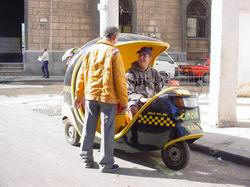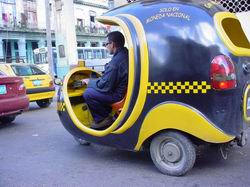Tribuna
de la Habana
February 25, 2006
A CubaNews
translation by Ana Portela. Edited by Walter Lippmann
http://www.tribuna.islagrande.cu/capitalinas/texto/febrero/coco25f.htm
¡¿COCOTAXI?!
By: Yuliet y Verónica
Photos: Oscar Camaraza
 The
difficulties of urban transportation are no secret for the people of the
capital. That is why there was hope when it was announced last year that 30
cocotaxis would offer service to the population in national currency and at
reasonable prices.
The
difficulties of urban transportation are no secret for the people of the
capital. That is why there was hope when it was announced last year that 30
cocotaxis would offer service to the population in national currency and at
reasonable prices.
Our weekly paper reported that this new form of transportation would begin,
experimentally, at three points of Centro Habana; one in Chinatown; another at
the intersections of Belascoaín and Maloja and finally Galiano and San Miguel.
Before putting this service in practice, Jorge Luis Díaz Hernández, commercial
and operations director of the PANATRANS taxi entity, declared that the service
would function every day, between nine in the morning and seven at night, at a
cost of three pesos for the first three kilometers and 40 cents for the next.
The driver will be required to transport the passenger to any point within the
capital’s perimeter.
DAILY
SERVICE
After
functioning for several weeks we asked people about the necessary service.
Iraida
Arencibia of Central Havana, who we found on line at Galiano and San Miguel,
said: “This is the first time I come. They are cheaper; yesterday I took one of
what we call the ten-peso taxis from Marianao and it cost me 60 pesos.”
Now she has
to go to the Pediatric Hospital with her daughter and since only two are
working, she’s had a long wait.
“We need
more coquitos, because the wait will be shorter,” she added
Gerardo Enríquez is a regular. “They are very useful, modestly-priced and they
even take you to the door of your house”. However, “look there is no sign
whatsoever; these three-wheel cars are overexploited; they have problems with
spare parts and the story is that there are only ten working. I still have to
see this here!”
Mileidis Casals and Carmen Menéndez , regular clients at Zanja and Rayo explain:
“The cost is great although there are generally only two instead of the ten
promised”.
Regarding the trip they said “Some drivers refuse to take you to where you live.
They really don’t go to every point in the city”.
After visiting the different points, Tribuna observed that there are only
two coco-taxis. We also observed that many points have no identifying signs nor
is there any information about the service for the population.
BOOST THE STOPS

Trying to find out the causes of this situation, we again spoke to Díaz
Hernández. We learned that although there are 30 coco-taxis set aside for
national currency transportation, today only 18 are technically available.
“These cars have been in use for five or six years he explained. Due to their
technical situation we decided that they should travel only 140 to 150
kilometers a day. In the morning we distribute ten cars to the three pick-up
points while in the afternoon we guarantee transportation with the remaining
cars.
“Although, at first, service was considered for short trips, we have observed,
in practice, that 80 percent of the trips are long and, therefore, due to the
time taken for far destinations together with so few cocos, they are rarely seen
parked at the pick-up points and so they do not satisfy the demands of the
population.”
Questioned about the refusal of some drivers to take persons to their
destination, he added: “I don’t doubt that some may be completing their service
and may tell the customer that he can’t go, for example to Santiago de las
Vegas, because they have only five kilometers left for work.”
“In these
situations, they must ask the controller to insure another for transportation to
the place requested”. If this situation continues, he said that those persons
affected should present their complaints to the central station in Ayestaran or
by telephones: 873-1411 y 878-8784.
He also
added “That signs have been ordered and paid but the Traffic [Department] is
responsible for putting them up.
About the
possibility of increasing this service he commented: We should extend it to
Habana Vieja. At present we have considered that it is more convenient to
strengthen the existing points before opening new ones.
Soon we
expect to totally re-motorize the fleet of cars”.
TRIBUNA DE LA HABANA
25 de febrero 2006
http://www.tribuna.islagrande.cu/capitalinas/texto/febrero/coco25f.htm
¡¿COCOTAXI?!
Yuliet
y Verónica
Fotos: Oscar Camaraza
 Para ningún capitalino resultan un
secreto las dificultades por las cuales atraviesa el transporte urbano. Por ello,
surgió una gran expectativa, cuando a finales del pasado año, se dio a conocer
que 30 cocotaxis prestarían servicios a la población en moneda nacional y a
precios módicos.
Para ningún capitalino resultan un
secreto las dificultades por las cuales atraviesa el transporte urbano. Por ello,
surgió una gran expectativa, cuando a finales del pasado año, se dio a conocer
que 30 cocotaxis prestarían servicios a la población en moneda nacional y a
precios módicos.
Nuestro semanario divulgó que la nueva modalidad comenzaría,
de forma experimental, por Centro Habana, municipio donde ubicarían tres puntos
iniciales de embarque, situados en el Barrio Chino y en las intersecciones de
Belascoaín y Maloja, así como Galiano y San Miguel.
Previo a la inauguración, Jorge Luis Díaz Hernández, director
comercial y de operaciones de la Empresa de taxis PANATRANS, informó que el
servicio funcionaría todos los días, de nueve de la mañana a siete de la noche,
con una tarifa individual equivalente a tres pesos en moneda nacional para los
tres primeros kilómetros, y 40 centavos los siguientes, y los
conductores tendrían la obligación de trasladar al pasajero hasta su destino
dentro del perímetro capitalino.
COTIDIANIDAD
Transcurridas varias semanas indagamos con los beneficiarios,
acerca del funcionamiento de la necesaria prestación.
A Iraida Arencibia, vecina de Centro Habana, la hallamos en la
cola de la piquera de Galiano y San Miguel. "Es la primera vez que vengo. Son
más económicos, pues ayer cogí un botero, desde Marianao, y fueron 60 pesos".
Ahora debe viajar hasta el Pediátrico con su hija y, como solo
hay dos trabajando, lleva buen rato en espera del turno.
"Hace falta que pongan más coquitos, pues mientras más hayan,
estaremos menos tiempo en los puntos", acotó.
Gerardo Enríquez es asiduo del lugar. "Son muy útiles, con
precios asequibles, te llevan hasta tu casa". Sin embargo, "mire, no existe
señalización alguna, los triciclos están sobreexplotados, presentan dificultades
para adquirir las piezas de repuesto, y eso de diez trabajando, ¡todavía estoy
por verlo aquí!".
Por su parte, Mileidis Casals y Carmen Menéndez, habituales
clientes de Zanja y Rayo, sostienen: "La tarifa es magnífica, aunque
generalmente trabajan dos vehículos y no los diez previstos".
Respecto al recorrido, manifestaron respectivamente: "Algunos
conductores se niegan a llevarte hasta el lugar de residencia. En realidad no
van a todos los puntos de la ciudad."
Después de visitar las piqueras, Tribuna corroboró que en cada
una de ellas, había solo dos carros. Asimismo constató que ninguna cuenta con
algún elemento identificador, ni se ofrece información sobre el servicio a la
población.
REFORZAR LAS PIQUERAS
 En
busca de las causas de tal situación, conversamos nuevamente con Díaz Hernández.
Así conocimos que de los 30 cocotaxis destinados a la transportación en moneda
nacional, hoy solo 18 presentan una adecuada disposición técnica.
En
busca de las causas de tal situación, conversamos nuevamente con Díaz Hernández.
Así conocimos que de los 30 cocotaxis destinados a la transportación en moneda
nacional, hoy solo 18 presentan una adecuada disposición técnica.
"Estos vehículos, explicó, tienen ya cinco o seis años de
explotación. A partir de su estado técnico, decidimos que cada uno recorra de
140 a 150 kilómetros diarios. En la mañana distribuimos diez carros entre los
tres puntos de recogida, mientras en la tarde garantizamos la transportación con
los restantes medios disponibles.
"Aunque inicialmente dicha opción fue concebida para tramos
cortos, la práctica demuestra que el 80 por ciento de los viajes son largos, por
tanto, debido al tiempo empleado en tan distantes recorridos, unido al hecho de
contar con tan pocos cocotaxis, provocan que apenas se vean en las piqueras y no
satisfagan la demanda de la población."
Interrogado sobre la negación de algunos choferes de llevar a
las personas hasta su destino, argumentó: "No dudo que alguno esté terminando el
horario, entonces le diga al usuario que ya no puede ir hasta, por ejemplo,
Santiago de las Vegas, porque solo le quedan cinco kilómetros por recorrer".
"Ante esos casos, insistió, deben exigir al controlador para
que otro asuma la transportación hasta el lugar deseado". De persistir dicho
comportamiento, llamó a los afectados a presentar sus quejas en el puesto de
mando de la base, ubicada en Ayestarán, o por los teléfonos 873-1411 y 878-8784.
Argumentó además: "La señalización está contratada y pagada,
mas corresponde la ejecución a Tránsito".
Sobre la posible ampliación de la modalidad, comentó:
"Debíamos extenderla a La Habana Vieja. Actualmente analizamos que resulta más
conveniente reforzar los puntos existentes, antes de abrir otros nuevos.
Próximamente iniciaremos la remotorización total del parque".
 The
difficulties of urban transportation are no secret for the people of the
capital. That is why there was hope when it was announced last year that 30
cocotaxis would offer service to the population in national currency and at
reasonable prices.
The
difficulties of urban transportation are no secret for the people of the
capital. That is why there was hope when it was announced last year that 30
cocotaxis would offer service to the population in national currency and at
reasonable prices. 